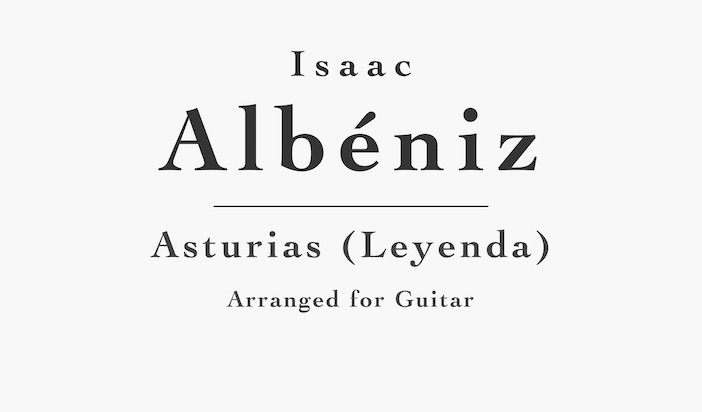
Asturias (Leyenda) – No. 5 from Suite Española, Op. 47 by Isaac Albéniz (1860-1909). PDF sheet music or tab arranged for classical guitar. The level is fairly advanced (Grade 10). I’ve based this mainly on arrangement on the piano score and my own ideas but was also influenced by the John William’s performance. Isaac Albéniz was a Spanish pianist, composer, and conductor. He is one of the foremost Spanish composers of the Post-Romantic era. He is best known for his piano works based on Spanish folk music idioms. He actually never wrote guitar music but was certainly influenced by it which explains why Asturias on guitar actually works quite nicely (tremolo and repeated notes are difficult on keyboard).
Buy My PDF Sheet Music Edition – Includes both notation edition and a separate tab edition.
- Asturias by Albeniz from Werner Guitar Editions – my dedicated sheet music store.
Video Lessons & Performances of Asturias
My video lesson on for Asturias, 40min of walk-through and discussion. Watch Pepe Romero’s video below for a very similar performance of my edition. Here’s the Youtube lesson link if you want to watch it there. In the video, in measure 42 I play a high E instead of C so follow the score as it is correct.
Pepe Romero plays Asturias-Leyenda by Albeniz – Pepe Romero’s fingering is very close to my edition, the upward arpeggios at 59 are different, but especially the inner rubato section with chords instead of harmonics is super similar. I’d start here.
Isaac Bustos plays Asturias Leyenda by Albeniz I like lots of what Busto’s is doing here but it’s different as is the Vidovic in the following.
Ana Vidovic plays Asturias Leyenda by Albeniz

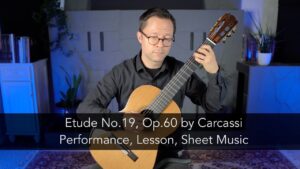
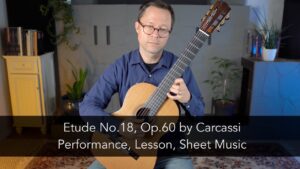
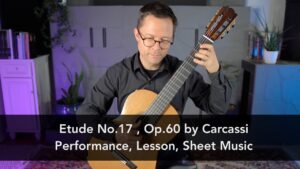
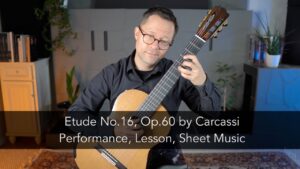
Hi Bradford, recently bought your arrangement and rapidly coming to the conclusion that my teacher is a little misguided in thinking and I can tackle this at my stage of development. However, on a technical note, I am stumbling at Bar 15 where you use your second finger to cross to the A and my teacher insists on my just jumping there with my first finger, leaving the B and crossing to the A that way. But what I wanted to say is while your solution is way better, you don’t appear to be playing the D that starts the third beat of this bar. At least I watch and watch and don’t see it. Also in the score you have fingered it with a 1? Can you please clarify. Thanks, David.
Yes, measure 15 in my sheet music is fingered as I indeed to play it. That is the fingering I’m using. Because of the split second and intervening B you could use 1 on the A but I found that at faster speeds I could get more out of the B resonance by holding it longer with 1. I’ll make an updated video on the piece soon but I did check over the score recently and I think it’s how I intend.
ps. Always listen to your teacher! They often know what’s best for your unique development.
All your site is so helpful; many thanks
Hi Mr Werner, I was just wondering, how do your arrangement compare to Segovia’s?
Best wishes
I would say mine is a bit plainer in some ways. Not plain in a bad way, but more close to the original and a bit less ‘guitaristic’ in terms of effects etc. Maybe more ‘presentable’ if one could say such a thing. Both editions are good. With pieces this big you’ll want to get as many versions as possible and compare them to see what you like.
Mr Werner, would you please make a piece of La Caterdral for intermediate. I do like the rythm played by Mc Alister. Very much thank you.
THis is great ! But I am following you at page 46 of your method (volume 1). I hope you will have a detail guideline about this version someday. In fact, I prefer the version played by Sharon Isbin (here: https://www.youtube.com/watch?v=yIjfkYKKW54). Its like you are drinking a red wine. I heard John 16 years ago but he played it quick and strong not like Andrea Sagovia.
Great thanks any way. A silent online student of yours from Vietnam.
Clearly this is a beginner arrangement, hope you find it easier than the original. However, did you notice I have the original posted for free on the site: https://www.thisisclassicalguitar.com/asturias-leyenda-by-albeniz-free-pdf/
Hi, how do I download the original one?
Life took over, and after playing the classical guitar for 18 years, and being rather good at it, I stopped for 57 years.
I have now started again. It is very exciting as everything seems to be coming back, but the easy version is too easy.
I also tried to play Cavatina, but my hands are small, and I wonder whether there is an easier version.
Many thanks
The original is for piano, you can find it on imslp and elsewhere (google it!).